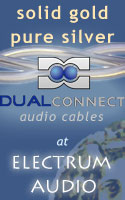
You are reading the older HTML site
Positive Feedback
ISSUE
24
audio art
IC1 and IC3 interconnects
as reviewed by Ed Kobesky

 |
|
|
You are reading the older HTML site
Positive Feedback
ISSUE
24
audio art IC1 and IC3 interconnects as reviewed by Ed Kobesky
|
|
|
Reviewing interconnects is like evaluating the broiler in your favorite steakhouse. It's hidden most of the time, so all you can really appreciate are the results. It may have shiny stainless steel doors and a glowing LED temperature readout, or it may be tarnished and stained from preparing thousands of dinners for the local Elks Club. Who cares, as long as it gets hot enough to make the meat sizzle? How would you compare two identical cuts of meat prepared in different broilers? You'd make sure that both cuts were the same size, that both were seasoned identically, and that they were cooked to the same degree of "doneness." Then you'd taste. Of course, the first bite might taste better just because it's the first bite, which means that the first bite from the second steak might not taste as good. When I go to a steakhouse, I don't ask to see the broiler, and when I review interconnects, I take it on faith that there's metal in there, wrapped in some kind of insulation and covered in a jacket. That's as far as I go. I don't want to hear the marketing spiel. The cable business is full of tall tales, and rather than being influenced by a story that appeals to me, I'd rather just listen. For the record, I have owned my share of expensive cables from companies like Audioquest and Kimber, but can't justify spending megabucks for cables that offer only minor improvements. I sold my pricey cables and spent the money for other things. Audio Art cables are priced competitively with chain store brands, and cost far less than $100 for normal lengths. For this review, I listened to my Monster Interlink 250 and 400 interconnects for a few weeks, then switched to the Audio Art interconnects for a similar period. From time to time, I would swap them to compare a particular track, but not often. Strictly on build quality, the Audio Art cables deserve high marks. I was impressed by their substantial appearance and feel. They look good enough to fool you into thinking you paid a lot more than a measly $79 for a half-meter pair of the silver/copper stranded IC3s, or $39 for the same length of the all-copper IC1s. In terms of sound, the Audio Art cables offered a clearer view of the performance than my Monster cables, though not startlingly so. They brought me a step or two closer to the original recording and cleared away some low-level sonic junk. They also created a less constricted and more natural soundstage. That's the most I can ask of any cables, and some much more expensive ones fail to achieve it. The Audio Art cables were not noticeably dry, bright, or warm. I tried them with several sources (Rega Planet, Sony SCD-CE595, Parasound CD/P-1000) and two integrated amps (PrimaLuna ProLogue Two and Cambridge Audio Azur 340A), and came to the same conclusion each time. Bear in mind that Audio Art aims its products at the conservative audiophile. Their interconnects were designed and tested in a system consisting of a Rega analog front end with Creek and Manley amplification driving Tetra speakers. That's my kind of system. If yours costs ten times as much, you might want to look elsewhere. You may hear colorations my system couldn't reveal. Then again, maybe not. After listening, I checked out Audio Art's website, and was pleased to find a refreshing lack of bullshit. The company's aims to deliver the same performance as higher-profile brands without the inflated prices. Okay, we've heard that before. Keep reading and you'll find, as I did, that Audio Art founder Rob Fritz worked with DH Labs to find a Taiwanese supplier who could deliver comparable quality at much lower prices. Despite his relationship with DH Labs, Fritz stresses that his cables are "100% exclusive designs. None are actually an existing DH product in a different 'wrapper'." Even if the Audio Art cables don't have a prestigious name, they're built as well as anything in their price range and sound very good. The commendably smooth sounding IC1s were a definite improvement over my Monster cables for just a few extra dollars. The IC3s sounded more detailed and a bit airier, though perhaps a teeny bit clinical—not bright enough to change the inherent character of a component, but worth mentioning if your system leans to the edgy side. Audio Art offers 100% USDA prime performance at ground chuck prices. If you are thinking of settling for what you can buy at your local electronics superstore, give these a try. At the very least, you will be dealing with a passionate audiophile like Rob Fritz, and will get great advice on cable selection. This you will never get at a chain store. All other things being equal, I'd rather see my money go to Rob. His cables come with a 30-day satisfaction guarantee, so you'll have plenty of time to decide whether or not they do the job. I think you'll find that they're well worth the money. In fact, you might find that you no longer need to waste time comparing cables, which will give you time for more meaningful investigations like USDA Prime vs. USDA Choice, or wet aging vs. dry aging. See you later—all this talk of interconnects is making me hungry. Ed Kobesky
Audio Art
|